Referring to the article entitled ‘City is playing valuations games’ published on the 4 April by the Cape Argus, Swindon Property would like to address key factors and discuss opposing views written in this article.
It is our belief that the Computer Assisted Mass Appraisal system (CAMA) used by the City of Cape Town is very effective in some areas and a more transparent relationship between the City and property owners would have a positive impact on the valuation process.
The statement made by Mr Phillip Bam reads as follows:
“But the system that the City is using is really outdated and unfair. They use the market value of the properties and that in itself is a problem. The markets are affected by so many other factors. Let’s take an area like Grassy Park where the roads are not often maintained. Go to Constantia or Bishopscourt where roads are much better. Now the same system or formula is used for both areas. Now in certain respects the market values between areas are different, but that does not mean that the same system should be used for the City.”
With all due respect to Mr Bam, we would like to highlight some of our opposing views. Although the City’s system is not perfect, it does value the lower to middle-income neighbourhoods accurately. The reason for this, is that the value band in these neighbourhoods are small when compared to the upmarket neighbourhoods.
With this CAMA system, sales from the same area as the valued property are applied. In essence, if the roads are bad for the Property being valued, it impacts on the values derived by the sales applied by the City’s valuation system.
The problem is more evident in the upmarket areas. In these nodes, the value bands are quite broad. For example, a house of R5,000,000 could be situated adjacent to a house of R25,000,000. Should a few of the houses in the upper region of this parameter sell, this would impact heavily on the average rate per m² applied to this node.
For different reasons to Mr Bam, we consider the communication between departments within the City a problem more so than the system.
Our Valuations Division have first-hand experience for an excess of 20 years as well as being involved on both sides of the General Valuation, we have strong knowledge and thorough understanding of the system and the application thereof.
Where the City is lacking in our opinion, is the valuing the commercial sector. If this was undertaken in a more thorough manner, the burden would not be placed on the residential market to assist the City to make up their budget requirements.
When valuing the commercial sector, there are two impacting problems:
Firstly, there is a lack of communication between the building department and the valuations department. With daily valuation work, it is often noted that a property which was previously vacant and now redeveloped has not been revalued as an improved site. This affects income for the City.
Secondly, the method used to value commercial property is the same as residential property, this should not be the case. It may work to some degree for Sectional Title commercial sites but freehold cannot be valued on the same
method. There are too many factors to consider and this cannot be reflected in a common rate per m² indicated by this computerised system.
Impractical to value properties every year
The statement by Mr Johan van der Merwe, Mayco member for Finance, mentions that properties should be valued every year. This is not a practical solution as the City can barely cope with the General Valuations which take place every three years. Yearly valuations would not assist in resolving this matter.
By having an alternative system in place whereby owners of commercial properties are requested to complete income and expenditure on the website, as with the GV2000 exercise, would assist in making commercial properties values more accurate. In our opinion, the residential market carries the burden of the budget as commercial properties are not valued correctly.
If commercial properties were valued correctly, monies could be collected more fairly and the burden especially on the lower income nodes could be alleviated to some degree. In agreement with Mr Bam, property prices are too expensive for first time owners and the further burden of overstated rates and taxes makes it almost impossible for first time buyers to enter the market.
In conclusion, the City needs a more effective and transparent attitude to property owners, enabling the city to support property owners rather than hinder them. Making information more freely available to all property owners will bring more clarity and confidence to the property market. The second factor noted in this article is the increase in tariffs. In the defence of the City, the rates and taxes tariffs were decreased with the implementation of the previous General Valuation 2015 effective 01 July 2016. If the municipal valuations increase to the same degree as previously it would be prudent for the City to do the same this time round.
This takes into account the increases foreseen for other costs that include refuse and sewage, that will significantly impact the lower to middle income nodes. In our opinion, The City is treading on thin ice. The increased VAT, increases food and transport, the most significant costs other than housing, places a further burden on property owners. How far is the City prepared to go to justify their increases? The proposed increases are substantially higher than increases in salaries with families living on the breadline already.
In closing, we believe that the City should be building a relationship with property owners as opposed to breaking down communication channels. If people were more informed and privy to the intentions of the City a better relationship could be established with property owners. It can be said that most property owners do not argue with paying property expenses but more so disagree with the exploitation of the money collected.







